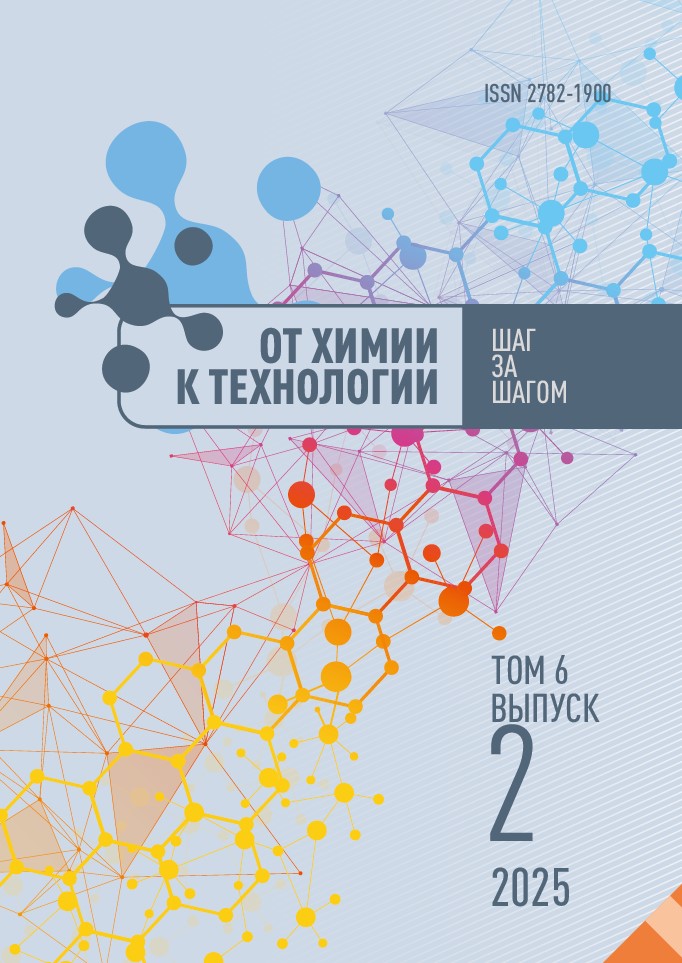Yaroslavl, Yaroslavl, Russian Federation
Yaroslavl, Yaroslavl, Russian Federation
Yaroslavl, Yaroslavl, Russian Federation
Yaroslavl, Yaroslavl, Russian Federation
UDC 546.723
The paper considers the mechanism of solid-phase interaction of potassium monoferrite with hematite. The authors assigned the role of iron oxide as a matrix for the creation of further structure of the catalyst. For the experiment the authors prepared pill samples of potassium monoferrite and haematite. The pills were placed in a special clamp and heat-treated. We investigate the mechanism of solid-phase interaction in the KFeO2-Fe2O3 system by the artificial mark method. We used the q parameters calculated from XRD data to assess the ratio of products of the solid-phase interaction between potassium monoferrite and haematite. The article presents a bar chart of the parameters q[(0111)], q[(017)] and q[Fe2O3(110)] as a function of the depth of potassium penetration into the haematite volume. Analysis of the structures of haematite and potassium polyferrites suggests that alkali metal ions diffuse into the haematite lattice. In the polyferrite formed, the movement of cations continues between blocks of composition {Fe11O17}. K+ ions occupy the correct positions in the lattice of the formed polyferrite. A layer rich in potassium β″-polyferrite is located closer to the pill contacts boundary. During the removing of the pills from the contact boundary, there is a formation of alkali metal polyferrites with -alumina and -alumina structures. The distance from the contact boundary of the pills increases with decreasing of the content of β″-polyferrite following by increasing of the proportion of β-phase. The polyferrites formed are essentially solid electrolytes capable to ensure the transportation of alkali metal ions through specific channels in the polyferrite structure. The paper presents the dependence of the factor f(β″) on the degree of transformation of potassium monoferrite into polyferrites during heat treatment of KFeO2+2Fe2O3 mixtures at 1150 K. It also describes the ratio of β- and β″-phases in the products of ferrite formation. As the degree of transformation is increasing, the f(β″) decreases, reaching a certain ratio of β- to β″-polyferrites. In this case the energy of coherent coupling of the β- and β″-phases ensures rapid stabilisation.
potassium monoferrite, hematite, solid-phase interaction, polyferrites with -alumina and alumina structure
1. Dvoretckaya A.N., Anikanova L.G., Sudzilovskaya T.N., Malysheva Z.G., Dvoretsky N.V. Electrical conductivity of potassium polyferrite doped with doubly charged cations. From Chemistry Towards Technology Step-by-Step, 2024, 5(2), 140-146. Available at: https://chemintech.ru/en/nauka/issue/5176/view (accessed 24.12.2024).
2. Dvoretskaya A.N., Anikanova L.G., Dvoretskii N.V. Effect of the Precursor and Synthesis Regime on the Properties of Hematite for Preparing Promoted Iron Oxide Catalysts. Catal. Ind., 2023, 15(2), 144–151. DOI:https://doi.org/10.1134/S2070050423020046
3. Lamberov A.A., Dementyeva E.V., Vavilov D.I., Kuzmina O.V., Gilmullin R.R., Pavlova E.A. The influence of ceric oxide on phase composition and activity of iron oxide catalysts. Adv. Chem. Eng. Sci., 2012, 2(1), 28 33. Available at: https://www.scirp.org/journal/paperinformation?paperid=16714 (accessed 24.12.2024).
4. Dvoretskii, N.V., Anikanova, L.G., Malysheva, Z.G. Types of active centers on surface of promoted iron oxide catalyst. Izv. Vyssh. Uchebn. Zaved., Khim. Khim. Tekhnol., 2018, 61(6), 61-68. DOI:https://doi.org/10.6060/tcct.20186106.5658. Available at: https://ctj-isuct.ru/article/view/416/251 (accessed 24.12.2024) (in Russian).
5. Kotarba, A., Rożek, W., Serafin, I. & Sojka, Z. Reverse Effect of Doping on Stability of Principal Components of Styrene Catalyst: KFeO2 and K2Fe22O34, Journal of Catalysis, 2007, 247(2), pp. 238-244 [online]. Available at: https://doi.org/10.1016/j.jcat.2007.02.009 (accessed 11.02.2024).
6. Joseph, Y., Ketteler, G., Kuhrs, C., Ranke, W., Weiss, W., Schlögl, R. On the Preparation and Composition of Potassium Promoted Iron Oxide Model Catalyst Films, Phys. Chem. Chem. Phys., 2001, 18(3), pp. 4141 4153. DOI:https://doi.org/10.1039/B104263G.
7. Li Zh., Shanks B.H. Role of Cr and V on the stability of potassium-promoted iron oxides used as catalysts in ethylbenzene dehydrogenation. Appl. Catal., A, 2011, 405(1–2), 101-107. DOI:https://doi.org/10.1016/j.apcata.2011.07.036.
8. do Carmo Rangel M., Mayer F.M., de Oliveira S.J., Marchetti S.G., Faita F.L., Ruiz D., Saboia G., Dagostini M.K., Morais J., Alves M.D.C.M. Dehydrogenation of ethylbenzene to styrene over magnesium-doped hematite catalysts. Appl. Catal., A, 2024, 669, 119514. DOI:https://doi.org/10.1016/j.apcata.2023.119514.
9. Shijie L., Tong C., Changxi M., Weimin Y., Zaiku X., Qingling C. Deactivation of the Industrial Catalyst for Ethylbenzene Dehydrogenation to Styrene. Chin. J. Catal., 2008, 29(2), 179-184. Available at: https://www.cjcatal.com/EN/Y2008/V29/I2/179 (accessed 12.12.2024).
10. de Souza Ramos M., de Santana Santos M., Gomes L. P., Albornoz A., do Carmo Rangel M. The influence of dopants on the catalytic activity of hematite in the ethylbenzene dehydrogenation. Appl. Catal., A, 2008, 341(1–2), 12-17. DOI:https://doi.org/10.1016/j.apcata.2007.12.035.
11. Anikanova L.G., Dvoretskii N.V. Stabilization of Alkali Promoters in Structure of the Iron Oxide Dehydrogenation Catalysts. Catal. Ind., 2016, 16(1), 29-36. DOI:https://doi.org/10.18412/1816-0387-2016-1-29-36 (in Russian).
12. Shaskolskaya M.P. Crystallography. M.: Vysshaya Shkola, 1984, 376 p. (In Russian).
13. Chen M., Zhao E., Yan Q., Hu Z., Xiao X., Chen D. The Effect of Crystal Face of Fe2O3 on the Electrochemical Performance for Lithium-ion Batteries. Sci. Rep., 2016, 6(1), 29381. Available at: https://www.nature.com/articles/srep29381 (accessed 24.12.2024).
14. Anikanova L.G., Dvoretskii N.V. Distribution of alkaline promoters in the structure of iron-oxide dehydrogenation catalyst. Catal. Ind., 2013, 5(1), 74-79. doihttps://doi.org/10.1134/S2070050412040022.







